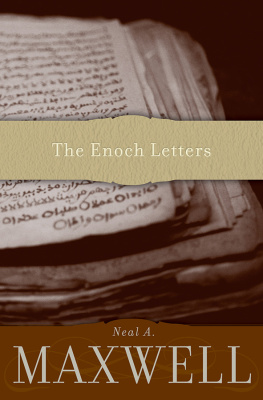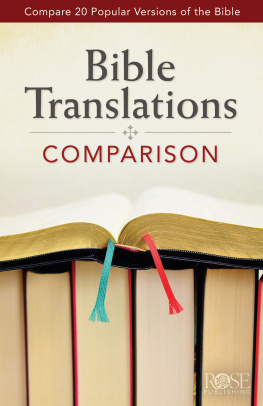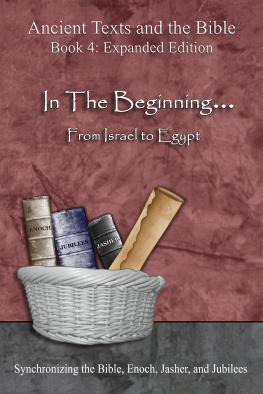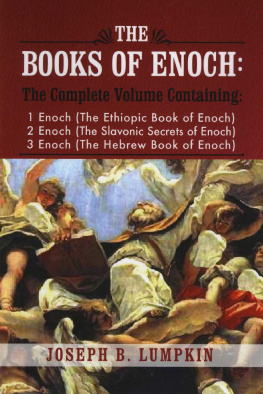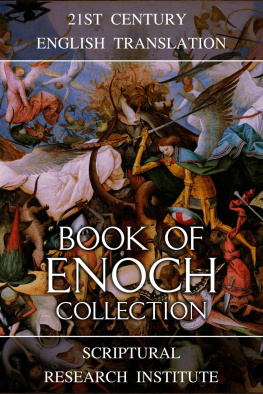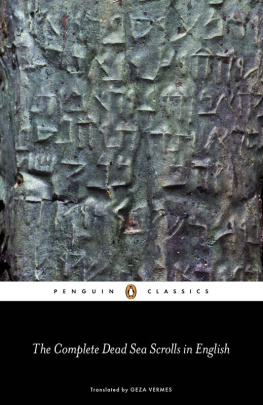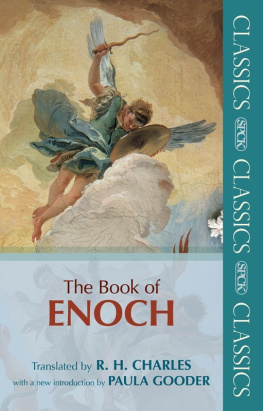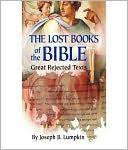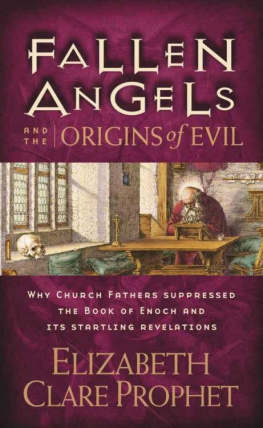1 Enoch
The Hermeneia Translation
George W. E. Nickelsburg and James C. VanderKam
Fortress Press
Minneapolis
1 ENOCH
The Hermeneia Translation
Copyright 2012 Fortress Press. All rights reserved. Except for brief quotations in critical articles or reviews, no part of this book may be reproduced in any manner without prior written permission from the publisher. Write: Permissions, Augsburg Fortress, Box 1209, Minneapolis, MN 55440.
Cover art: Photograph of 4QEnc i 6 (PAM 43. 199), a Qumran manuscript of the Aramaic of 1 Enoch 1314. See J. T. Milik, The Books of Enoch: Aramaic Fragments of Qumrn Cave 4 (Oxford: Clarendon, 1976), plate XII. For Miliks reconstruction of the text and its translation, see ibid., pp. 19294. Photo reproduced by permission of the Israel Antiquities Authority.
Cover design: Ivy Palmer Skrade
Interior design: The HK Scriptorium
Print ISBN: 978-0-8006-9910-9
eBook ISBN: 978-1-4514-2437-9
Library of Congress Cataloging-in-Publication Data
Ethiopic book of Enoch. English.
1 Enoch : the Hermeneia translation / George W. E. Nickelsburg and James C.
VanderKam.
p. cm.
Includes bibliographical references.
ISBN 0-8006-3694-5 (alk. paper)
I. Title: One Enoch. II. Title: First Enoch. III. Nickelsburg, George
W. E., 1934- IV. VanderKam, James C. V. Title.
BS1830.E6A3 2004b
229 .913dc22
2004015048
This book was produced using PressBooks.com.
Contents
1 Enoch is a collection of apocalyptic (revelatory) texts that were composed between the late fourth century B.C.E. and the turn of the era. The size of the collection, the diversity of its contents, and its many implications for the study of ancient Judaism and Christian origins make it arguably the most important Jewish writing that has survived from the Greco-Roman period.
In this revised edition, we offer a translation that is based on a critical reading of all the ancient textual sources. In chapters 3782, it has been modified slightly from the first edition of this book (1 Enoch: A New Translation [Fortress Press, 2004]), and the whole is substantially the same as what appears in our commentaries in the Hermeneia commentary series, 1 Enoch 1 and 1 Enoch 2. The translation in chapters 171 and 83108 was prepared by George Nickelsburg, and that of chapters 7282 by James VanderKam. The two of us are responsible for the parts of the introduction that pertain to the sections that we have translated. A bibliography provides resources for further study.
We wish to thank the editorial board of HermeneiaA Critical and Historical Commentary on the Bible for their kind permission to publish our translation here in a separate format, and Fortress Press (facilitated by Neil Elliott, acquiring editor) for agreeing to print the revised edition. We are happy to acknowledge the fine work of Maurya Horgan and Paul Kobelski at the HK Scriptorium in designing and producing this work. We are also grateful to Sarah Schreiber for her help in proofreading the manuscript.
George W. E. Nickelsburg, The University of Iowa
James C. VanderKam, The University of Notre Dame
Abbreviations
Aram Aramaic
chap. chapter
Copt Coptic
Eth Ethiopic
frg. fragment
Gk Greek
Gka Akhmim manuscript of the Greek version
Gks Extracts of the Greek version quoted by the chronographer George Syncellus
hmt. homoioteleuton, that is, words or lines that end with the same or similar letters or words
lit. literally
ms(s) manuscript(s)
NT New Testament
Syr Syriac
v(v) verse(s)
Sigla Relating to the Translation and Its Textual Base
( ) Words supplied to clarify the translation. Also occasionally they indicate a parenthetical comment within the text itself.
< > Textual emendation, either changing extant words or adding others presumed to have been lost
{ } Words that are possibly not original
[ ] Words supplied to fill a physical lacuna in a manuscript
Enclosed word(s) presumed to be corrupt
.... A series of more than three periods indicates that a piece of text has been lost.
Chapter and verse numbers in boldface type indicate text that has been transposed from its place in the manuscripts.
Contents of 1 Enoch
1 Enoch divides into five major sections, which are followed by two short appendices: The Book of the Watchers (chaps. 136); The Book of Parables (chaps. 3771); The Book of the Luminaries (chaps. 72 82); The Dream Visions (chaps. 8390); The Epistle of Enoch (chaps. 91105); The Birth of Noah (chaps. 106107); Another Book by Enoch (chap. 108). The sections represent developing stages of the Enochic tradition, each one building on the earlier onesthough not in the order in which they presently stand in the collection. Overall they express a common worldview that characterizes this present world and age as evil and unjust and in need of divine adjudication and renewal. With the possible exception of the Book of the Luminaries, they focus on the common concern and expectation that a coming divine judgment will eradicate evil and injustice from the earth and will return the world to Gods created intention. Their authority lies in their claim that they transmit divine revelation, which the patriarch Enoch received in primordial times (Gen 5:21-24) and which is made public in the last times to constitute the eschatological community of the chosen.
The Book of the Watchers (Chaps. 136)
Chapters 15 were composed as an introduction to chapters 136, but now set the keynote for the entire work. They constitute a tripartite prophetic oracle, in which Enoch announces the coming theophany, when God and the heavenly entourage will render judgment against the rebel angels who introduced evil into the world and against sinful humans, who perpetrate it. The first section (1:1-9) paraphrases part of Moses final blessing on Israel (Deuteronomy 33) and an oracle of Balaam (Numbers 24) and bases Enochs authority on visions received in heaven and interpreted by angels. The second section (2:15:4), cast in the language of Israelite wisdom traditions, expands the indictment of all flesh (1:9) by contrasting the obedience of the heavenly bodies and the earthly seasons with humanitys disobedience. The final section (5:5-9) employs language from Isaiah 5666 to describe the blessings and curses that await the righteous chosen and the sinners.
Chapters 611 are an interpretation of Genesis 69 that identifies events of the primordial past with those of the authors time. The sons of God (Gen 6:2), identified as angels (watchers), led by their chieftain Shemihazah, rebel against God by mating with mortal women and begetting giants, who devastate the earth. The giants can be interpreted as stand-ins for the warriors of the authors own time (the Hellenistic kings). The Genesis description of the Flood flows into a scenario that is appropriate for Gods eschatological judgment and the inception of the new age. Interwoven with the myth of the watchers and the women is a second pair of myths, which identify the sin of the watchers as the revelation of forbidden secrets (metallurgy and mining, magic and the mantic arts) that promote violence and promiscuity. Here the rebel chieftain is Asael, a figure who resembles Prometheus, the rebellious divine figure of Greek myth. Humanitys plea, heard by the four high angels, triggers the judgment. With the sinful principals annihilated, a new age ensues with blessings for the chosen and those of humanity who have converted to the worship of God.


